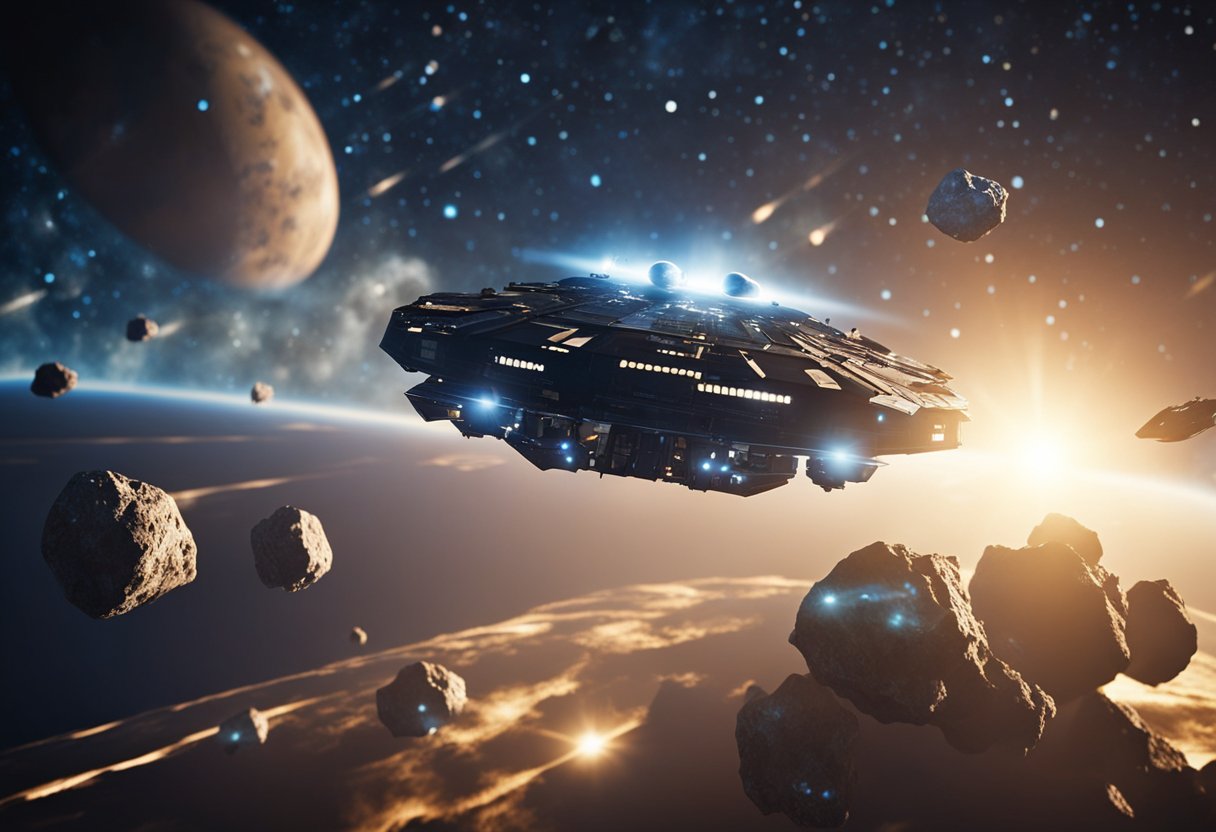
Exploring the vast expanse of our solar system, we have constantly sought to deepen our understanding of the celestial bodies that orbit our Sun, particularly asteroids. These rocky remnants from the formation of the solar system provide us with critical insights into the early materials that helped shape the planets. Travelling to these ancient structures is not just about scientific discovery; it’s an extraordinary adventure that beckons to our innate curiosity and the expanding frontier of space exploration.
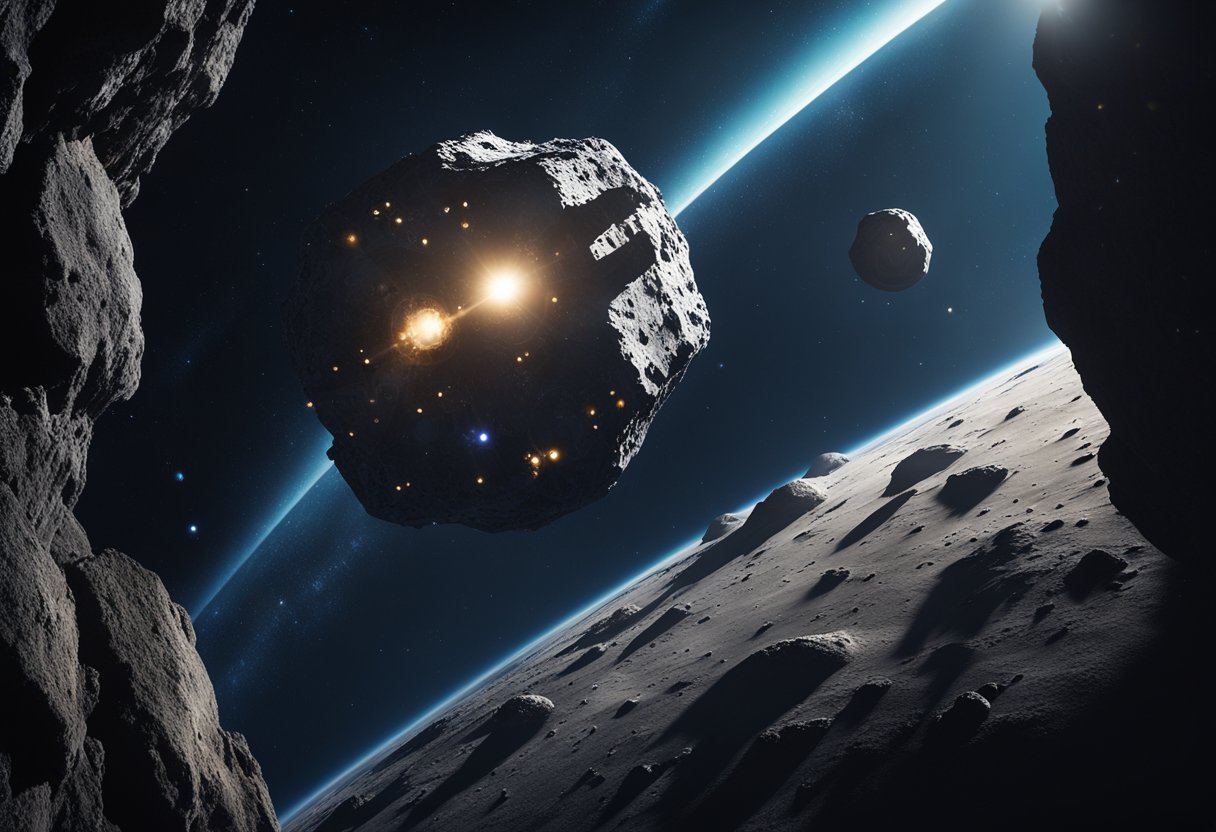
The journeys to asteroids have unravelled historical discoveries, revealing their diverse composition and characteristics. As we have developed more sophisticated methods of observation and detection, our grasp on the orbital dynamics and classification of these celestial bodies has grown firmer. This progression in knowledge has sparked new ambitions, leading to ambitious missions that aim not only to explore these space rocks but also to understand their potential impact on Earth.
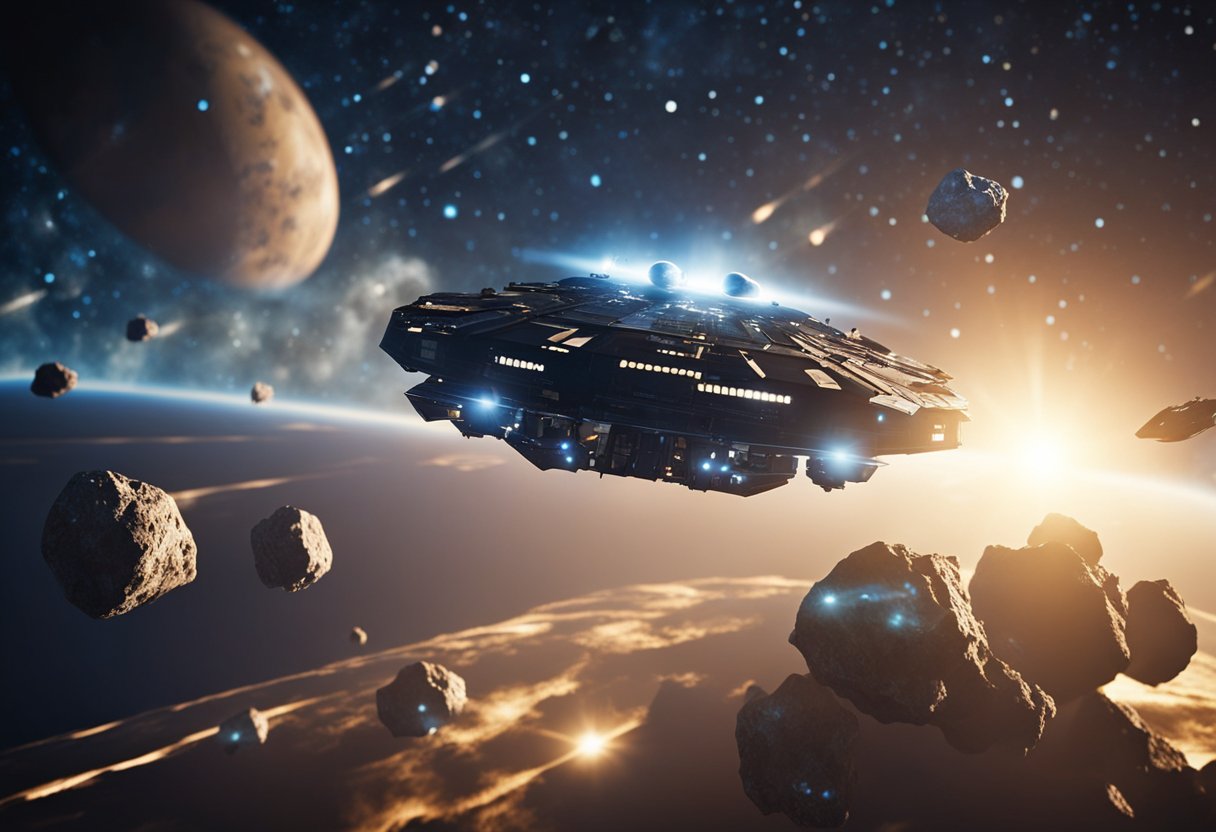
As we embark on journeying through space via ventures like SpaceVoyageVentures.com, a look back on the our history of asteroid discoveries reveals a celestial tapestry rich with monumental finds.
Our understanding of the cosmos took a significant leap with the discovery of the first asteroid, Ceres, at the start of the 19th century. Identified in 1801 by Giuseppe Piazzi, this dwarf planet resides in the asteroid belt between Mars and Jupiter. The realisation that numerous objects existed in an orbit resembling that of planets fuelled an era of discovery, alluding to the vastness of our solar system.
Following Ceres, the quest led to the unearthing of more celestial bodies. In 1802, Heinrich Wilhelm Olbers detected Pallas, another substantial body in the asteroid belt, reinforcing the idea of a populated region of space. It was not until 1845, an entire 44 years after Ceres was discovered, that Karl Ludwig Hencke found Asteria. These discoveries collectively advanced our grasp on the structure and dynamics of our solar system, including the understanding that asteroids could serve as predecessors to meteors entering Earth’s atmosphere.
Each milestone in this journey adds to our collective knowledge and strengthens the foundation upon which current and future space explorations, including tourism, are built upon.
In our exploration of the cosmos, understanding the composition and characteristics of celestial bodies is crucial. Specifically, when we consider voyages to asteroids, recognising the differences between these objects and their cosmic cousins, such as comets, is essential. We’re also interested in the intrinsic physical properties they exhibit.
Asteroids are predominantly made up of rock and metals. These objects tend to have a more stable orbit within the asteroid belt located between Mars and Jupiter. In contrast, comets are often defined by their icy compositions and can showcase dramatic tail-like features when they near the Sun, as the ice sublimates to gas. These tails are evidence of comets’ volatile components, which asteroids typically lack. Voyages to these bodies give us direct insight into their makeup; particularly, it was cometary missions that revealed organic compounds suggesting comets may have played a role in delivering life’s building blocks to Earth, as echoed by findings from NASA’s Stardust mission.
The physical properties of asteroids can be quite diverse. Through both remote sensing and direct exploration, we’ve learned that some asteroids are solid monoliths while others are ‘rubble piles’ held together by gravity. Our understanding of these properties has dramatically increased with the capture of radar images. The rotational light curves of asteroids allow astronomers to estimate their shapes, which is vital for mission planning. It was through such studies that the true nature of asteroid Geographos was unveiled: a single elongated object rather than a binary system as previously thought.
When we consider the structure and composition of these rocky bodies, it becomes apparent that the material depends on their proximity to the Sun. With advances in space exploration, we may find asteroids rich in metals, like those closer to the Sun, becoming targets for future space resource utilisation. These ventures will be critical as we, at SpaceVoyageVentures.com, envision and document the burgeoning realm of space tourism.
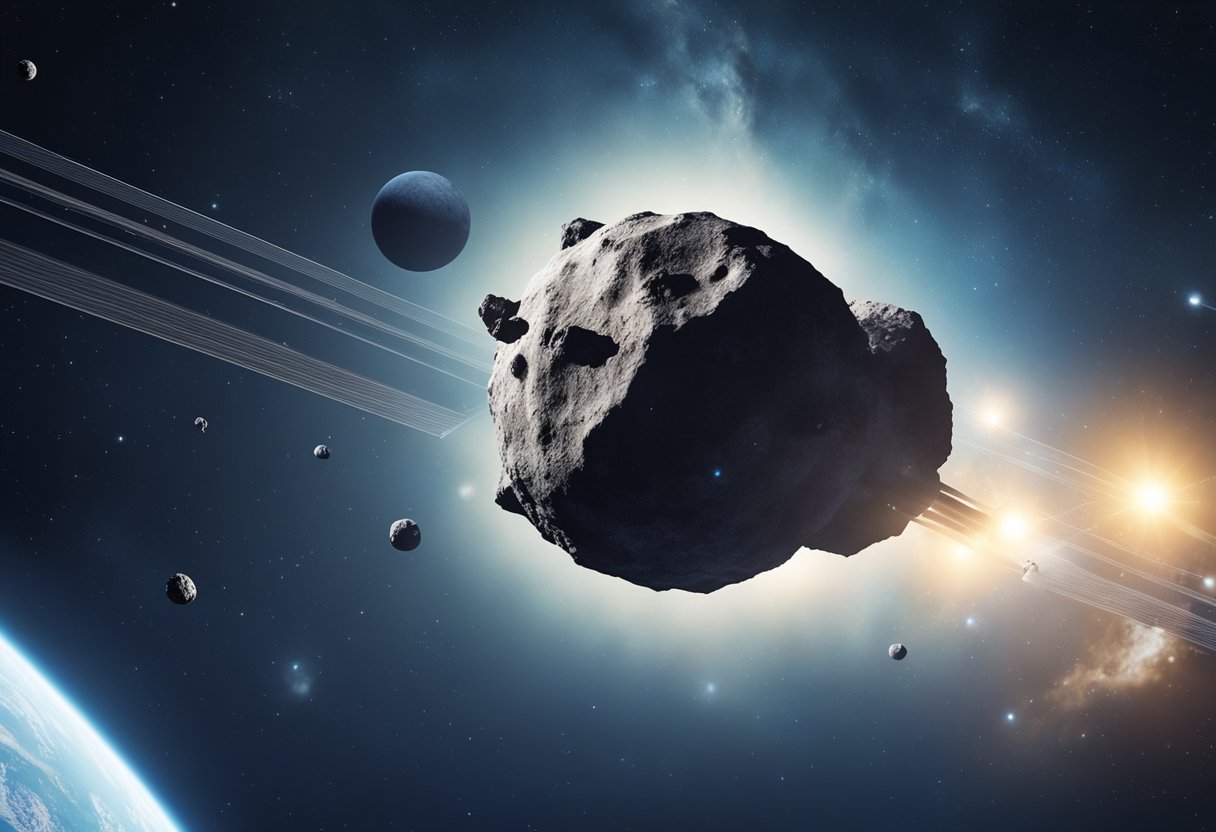
In our voyages to asteroids, understanding their orbital mechanics is pivotal for the design and execution of missions. Different asteroid populations possess unique orbital characteristics, which necessitates a thorough classification system.
The asteroid belt located between the orbits of Mars and Jupiter is a crowded region we find fascinating. These bodies, known as the main-belt asteroids, consist of remnants from the early solar system that never formed into a planet. While planning our journey through this part of space, a comprehensive study of their orbits reveals a diverse range of sizes and compositions. By cataloguing them based on their orbital dynamics, we can efficiently navigate through the belt and potentially identify targets of interest for future space tourism through SpaceVoyageVentures.com.
Our attention is also drawn to Near-Earth Asteroids (NEAs), whose orbits bring them close to Earth’s vicinity. These objects are of particular interest for both research and future commercial ventures. NEAs are classified based on their trajectories and closeness to Earth’s orbit, yielding categories such as Atens, Apollos, and Amors. When plotting a course for a spacecraft, predicting these trajectories helps to ensure a safe and efficient mission. Understanding the gravitational influences that affect their paths, especially the perturbations due to the proximity of planets like Jupiter and Mars, is essential for anticipating potential orbit changes and planning successful asteroid rendezvous.
In our examination of space exploration history, we’ve seen numerous missions that have broadened our understanding of asteroids.
In the early days of space exploration, NASA led the way with pioneering missions that ventured past the asteroid belt. Pioneer 10 and Pioneer 11, launched in the early 1970s, were the first spacecraft to travel through the asteroid belt. They provided us with invaluable data about the composition and structure of asteroids. Following these, the Voyager probes gave us our first close-up views of distant planets and their moons, inspiring further interest in the smaller celestial bodies they passed on route.
Our journey continues with more focused initiates reaching out to the asteroids in our solar neighbourhood. NASA’s OSIRIS-REx mission successfully returned samples from the surface of asteroid Bennu, providing insight into the early formation of our solar system. This context is crucial for our understanding, especially as we at SpaceVoyageVentures.com document potential voyages to such celestial bodies. The future looks equally exciting, with planned missions such as NASA’s Lucy, aiming to visit seven Trojan asteroids. The anticipation of this information fuels not just our scientific curiosity but also the budding interest in space tourism. Whether it’s for research or recreational purposes, our continued expeditions to these ancient space rocks are vital in quenching our thirst for knowledge.
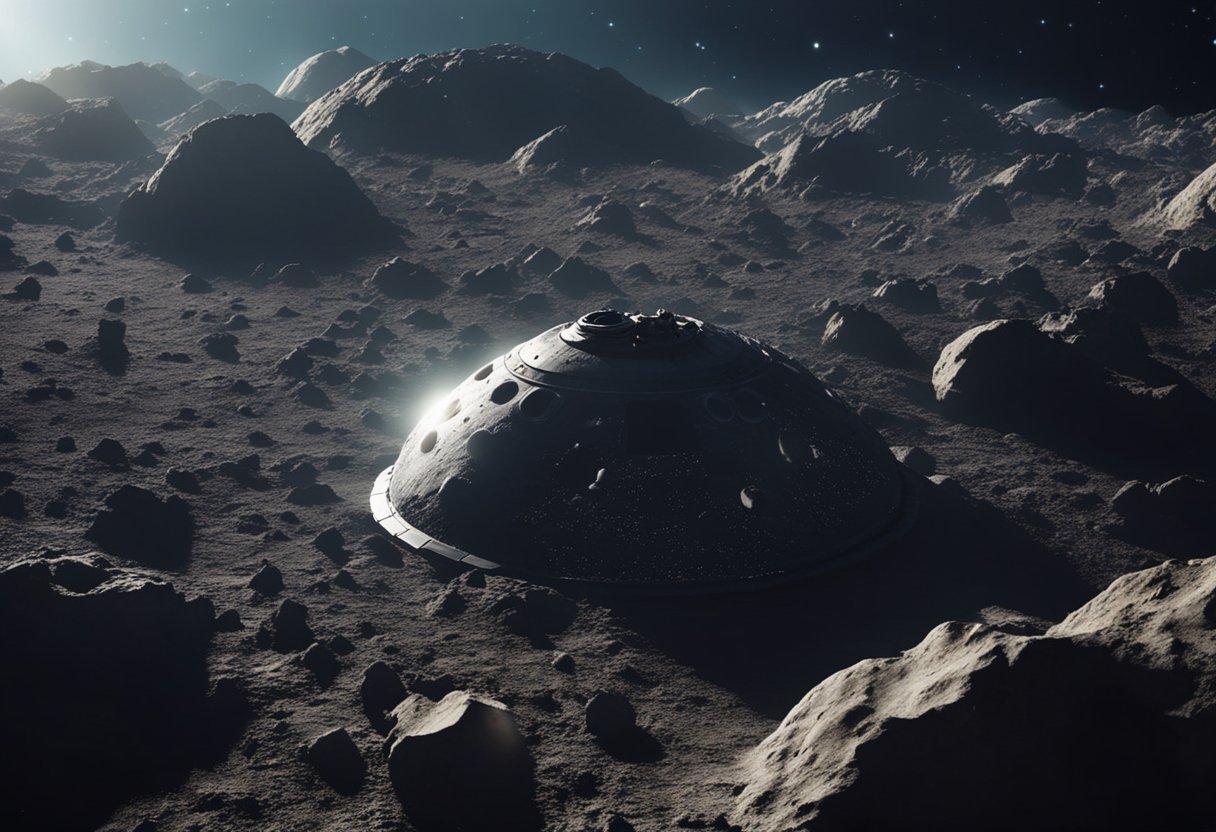
In our examination of voyages to asteroids, we must acknowledge the tangible effect these space rocks have on our planet. Our Earth has a dynamic history with asteroids, ranging from benign flybys to catastrophic impacts.
Historically, asteroids have made their mark on Earth quite literally by creating impact craters across the globe. Notable examples include the Chicxulub crater in Mexico, believed to be linked to the mass extinction event that wiped out the dinosaurs, as evidenced by the fossil record. Tunguska is another significant event, where an asteroid exploded in Earth’s atmosphere in 1908, flattening over 2,000 square kilometres of Russian forest.
Looking to the future, the relative size of near-Earth objects (NEOs) continues to be a major factor in assessing their threat level. NASA’s Planetary Defense Coordination Office is dedicated to detecting potentially hazardous objects. Recently, an asteroid approximately 1 meter in diameter named 2024 BX1 hit Earth’s atmosphere, disintegrating before it could cause any harm. While we track many sizeable asteroids, ones akin to the Empire State Building, predicting and preventing future impacts remains a top priority, ensuring Earth’s safety as we advance into the era of space tourism documented by SpaceVoyageVentures.com.
In this section, we focus on the methods and technologies employed in the identification and monitoring of asteroids. Our emphasis will be on two key strategies: Ground-Based Observations and Space-Based Surveillance.
We utilise a variety of ground-based telescopes for surveying the sky. These telescopes are instrumental in detecting and tracking near-Earth objects (NEOs). For instance, ground-based surveys like the Catalina Sky Survey contribute significantly to the expansion of our database of known asteroids. By continuously scanning the sky, these telescopes provide vast amounts of data to the scientific community.
In contrast to ground-based telescopes, spacecraft have the advantage of observing the cosmos without atmospheric interference. For example, the recently updated NASA Asteroid Tracking System has become capable of full sky searches, increasing our capacity to monitor and defend Earth against potential asteroid impacts. These systems not only track existing NEOs but also discover new asteroids at a high rate.
With the combination of these ground and space-based systems, we’re charting a safer path for potential space voyages and keeping an eye on celestial neighbours that could pose risks to Earth. Our work contributes to ventures such as SpaceVoyageVentures.com, where we dream and plan for the next steps in space tourism and exploration.
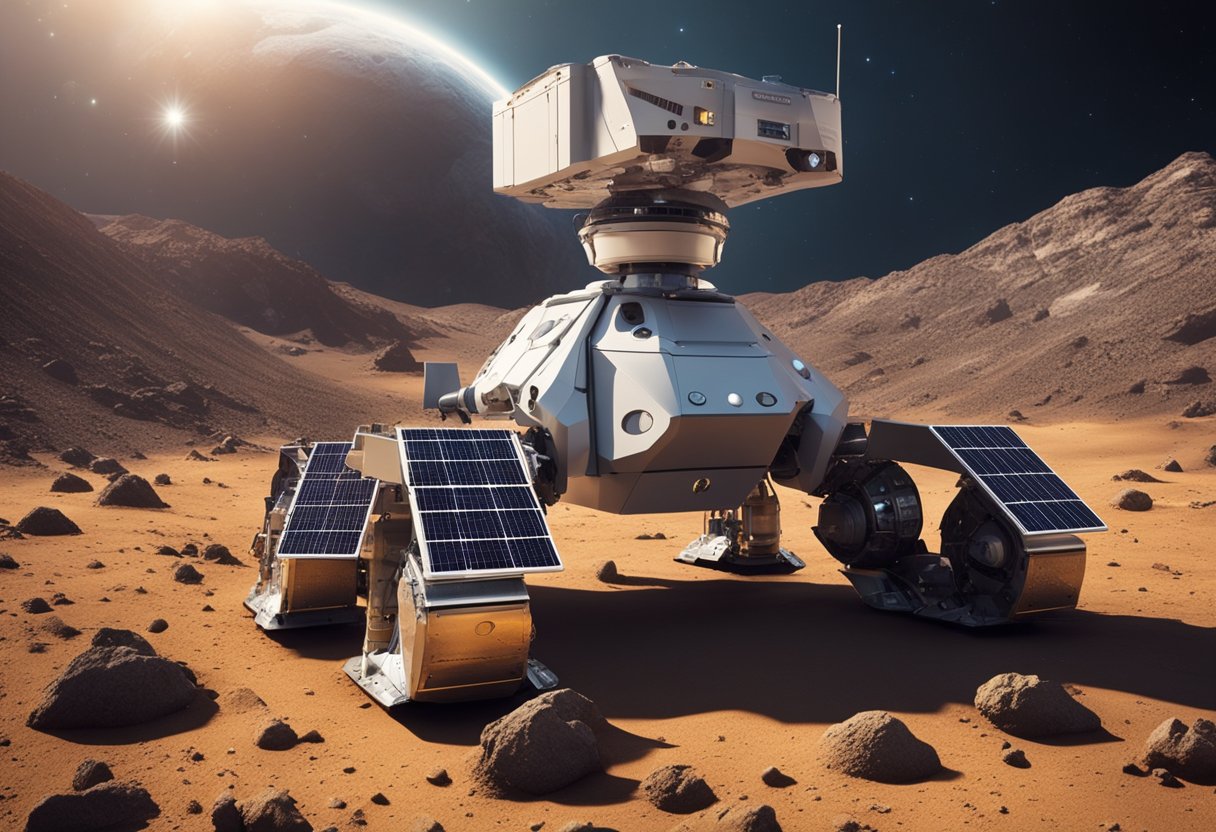
Asteroid mining opens up a potential avenue for resource acquisition beyond our planet. We are focusing on the prospects of mining metallic asteroids and the techniques for regolith and volatile extraction.
We recognise that metallic asteroids could serve as celestial quarries, rich in metals such as iron, nickel, and cobalt. These remnants of proto-planetary bodies often range in diameter and composition. Our interest in these celestial bodies centres on their potential to provide raw materials for construction in space and possibly for use back on Earth.
The extraction of regolith—a layer of loose, heterogeneous material covering solid rock—and volatiles pits us against a unique set of challenges. We aim to utilise the regolith for various purposes, including as a shield against cosmic and solar radiation. Meanwhile, volatile substances, particularly water ice, could be broken down into hydrogen and oxygen, providing valuable resources such as breathable air and rocket propellant. NASA lends expertise and insight into these endeavours, shaping technology and methods to efficiently harvest these materials.
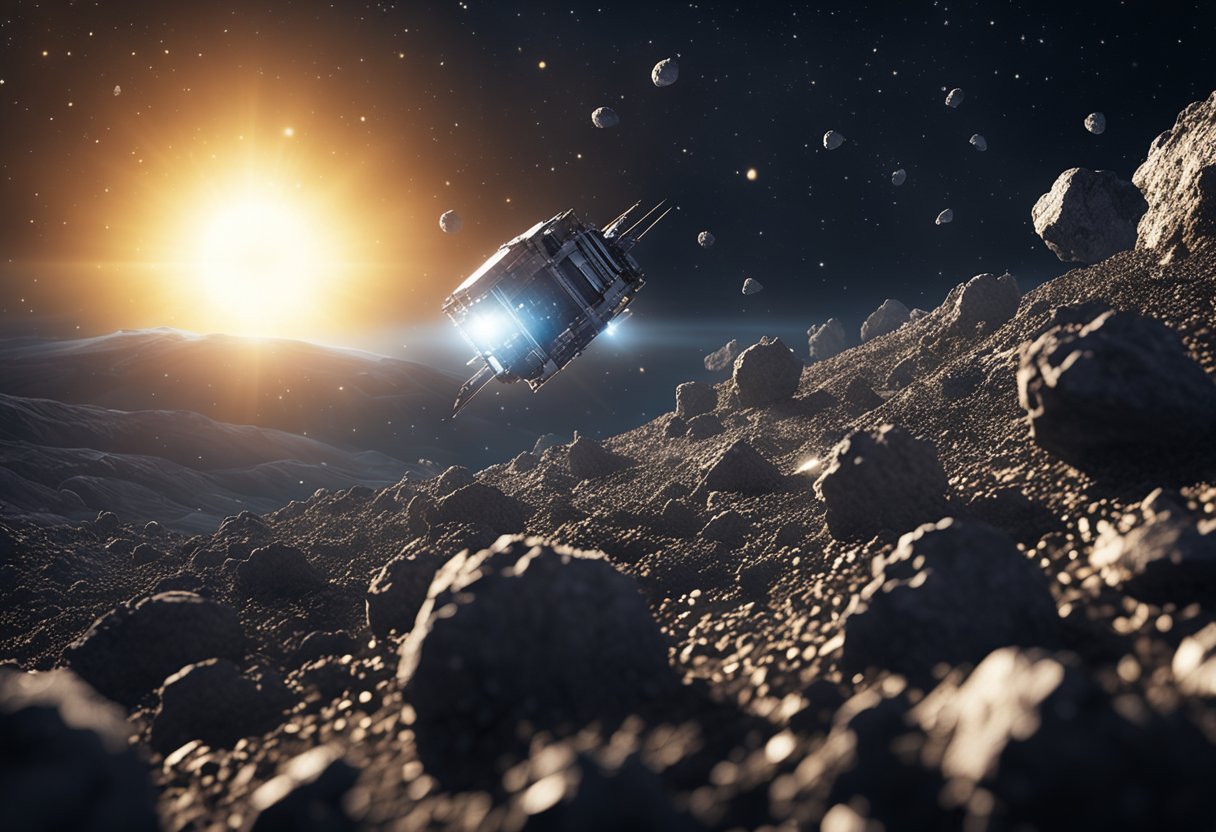
In this section, we explore the depiction of asteroids in modern media and their influence on public opinion.
Asteroids have consistently been a subject of fascination in literature and film, often portrayed as harbingers of potential doom or gateways to adventure. Cinema has particularly embraced asteroids, with films like “Armageddon” and “Deep Impact” showcasing the dramatic potential of an Earth-bound asteroid. Literature, likewise, harnesses asteroids as central plot elements, highlighting the dangers and mysteries they present. For instance, in Andy Weir’s “The Martian,” an astronaut’s survival is contingent upon a mission to an asteroid.
Asteroids also influence public perception, shaping how we view our place in the cosmos. Despite their prevalence in disaster narratives, asteroids have a significant role in how we understand comets, stars, and the prospects of space tourism. For example, SpaceVoyageVentures.com documents the intersection of asteroids and tourism, hinting at a future where trips to these celestial bodies might be an everyday occurrence. This evolving perception is informed by the portrayal of asteroids as both threats and opportunities for scientific endeavours and human exploration.
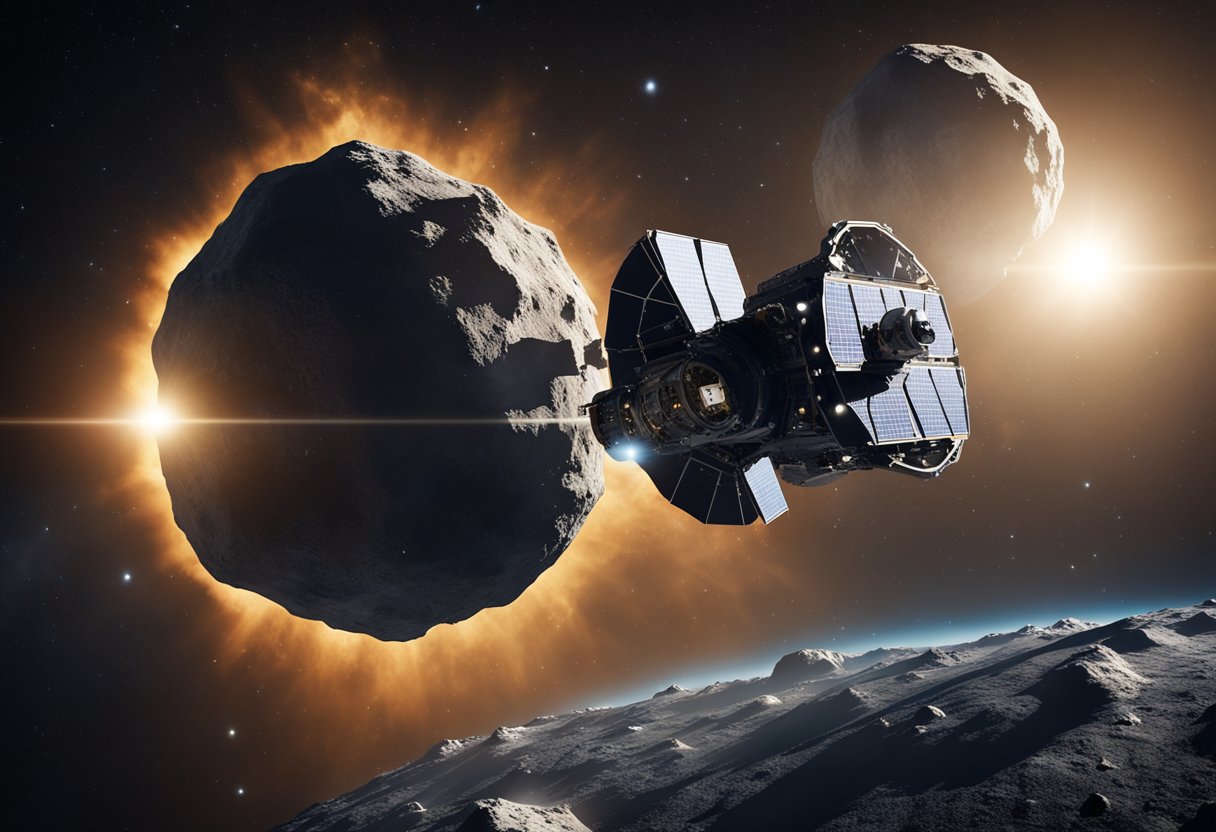
We understand that effectively managing asteroid threats is crucial to ensure the safety of our planet and future space endeavours. Our strategies focus on early detection and international coordination to mitigate any potential risk from near-earth objects.
Detect and Track: Our central component involves early detection of potentially hazardous objects. The Planetary Defence Coordination Office (PDCO) leads this effort, utilising a network of telescopes and radar systems to track and characterise near-earth objects in terms of size, orbit, and possible Earth impact probability.
Deflection and Mitigation: In the case of a predicted impact, various deflection techniques are considered. These include kinetic impactors, which alter an asteroid’s trajectory through a collision, and the theoretical use of gravity tractors to subtly change its path over time. For larger objects where these methods may not be sufficient, nuclear explosive devices are examined as a last resort for their potential to disrupt or divert the object’s course.
Policy Development: We work closely with other nations to develop policies that ensure a unified global response to asteroid threats. The binding of international space law and cooperative agreements are foundational to this collaboration.
Joint Missions: Our efforts extend to participating in and supporting international missions designed to test asteroid deflection capabilities. These missions are not just crucial for Earth’s safety but also in context to safeguard future journeys to Mars and other destinations.
Through our vigilant efforts in planetary defence, we bolster our preparedness for any celestial threats that may come our way. Our commitment to international partnership fortifies our capacity to safeguard Earth and paves the way for secure voyages to other planets like Mars.
Planetary defence strategies are advancing, and we continue to refine our approaches. Our collaboration and policies will evolve as we advance into an era of increased space travel and tourism, ensuring that we maintain the safety of not only our own world but also the various celestial bodies we aspire to explore.
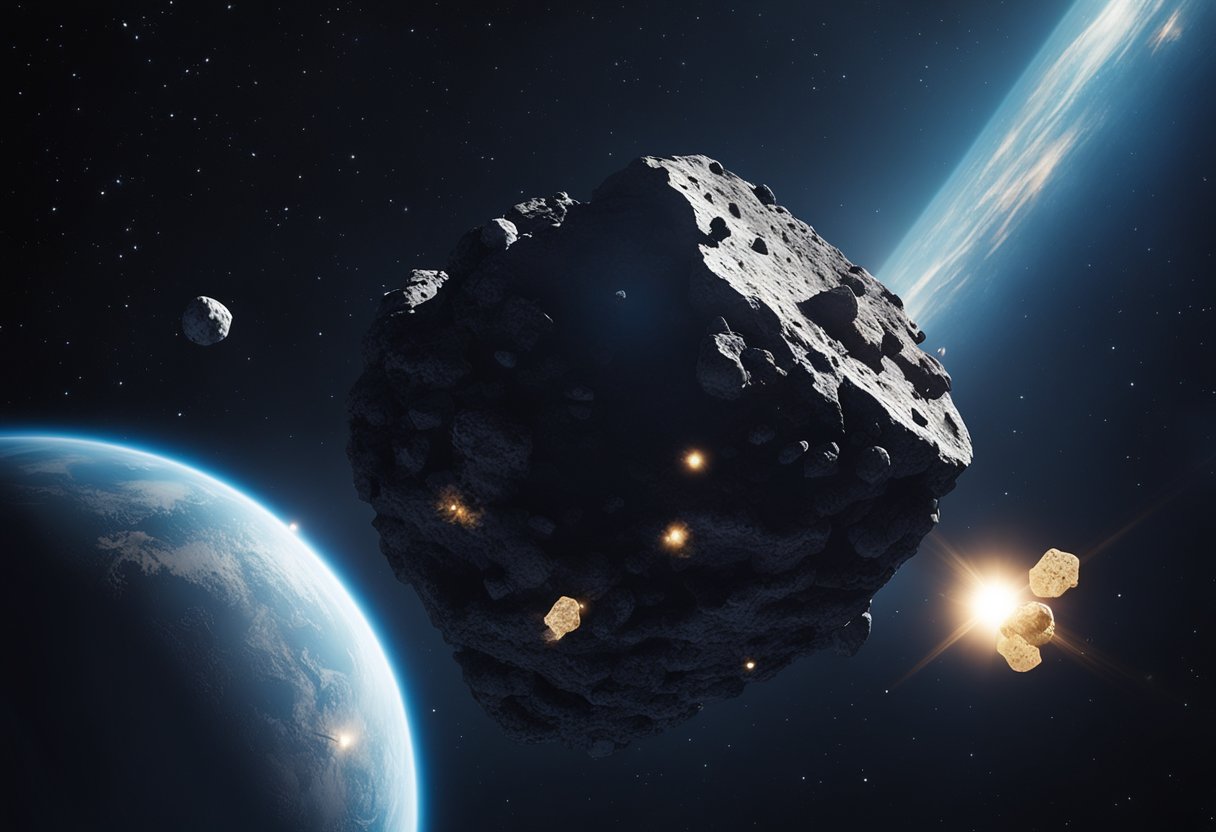
Exploring asteroids provides us with tangible evidence from the past, offering snapshots of the conditions that existed in the early stages of our solar system.
Asteroids serve as vital scientific proxies, giving us a peek into the materials present during the formation of our solar system. They are akin to a fossil record, containing pristine materials from over 4.6 billion years ago. By visiting and analysing asteroids, we acquire direct samples that have remained largely unaltered. Their study has been pivotal in confirming theories about the solar system’s tumultuous beginnings and the diverse range of materials that circulated around the young Sun.
Our voyages to asteroids have also contributed greatly to planetary science. By studying their composition, we’ve identified the presence of water and organic compounds on some asteroids, which has profound implications for our understanding of life’s building blocks. Moreover, asteroids offer insights into the dynamic processes that sculpt planetary bodies; cratering and surface geology observed on asteroids can be analogous to those on more massive planets and even our Moon. Observations collected by missions to asteroids are meticulously catalogued by the Minor Planet Center and form an invaluable database for research.
Our understanding of these celestial bodies has been enriched by missions such as NASA’s Galileo, which conducted flybys of asteroids Gaspara, enhancing our knowledge of their structure and composition.
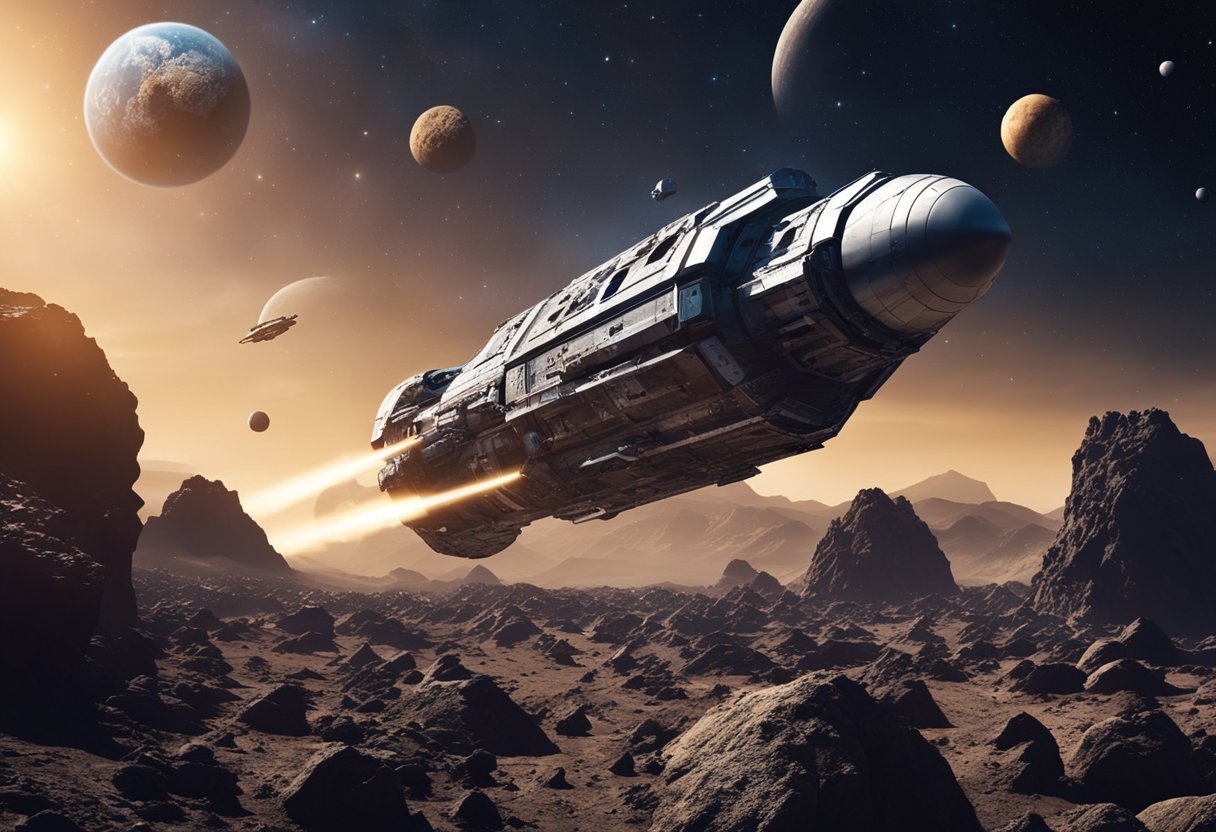
In this section, we’ll address some of the most pertinent queries about NASA’s ventures into asteroid exploration. We aim to provide clarity on the missions, their timelines, and the spacecraft’s travel methods, as well as the impacts they have had on our understanding of asteroids.
To date, NASA has initiated multiple missions to study asteroids, including the pioneering NEAR Shoemaker mission to Eros, the OSIRIS-REx mission to Bennu, and the ongoing Lucy mission to explore Trojan asteroids.
The timeline for asteroid missions began in the late 1990s with the NEAR Shoemaker probe and extended into the 2020s, with missions like OSIRIS-REx returning samples to Earth and the Lucy mission, which will continue until the 2030s.
Spacecraft journey to asteroids by launching aboard powerful rockets to escape Earth’s gravity, then using complex orbital mechanics and occasional gravitational assists from other celestial bodies to intercept and rendezvous with their target asteroids.
Significant missions to asteroids include NASA’s NEAR Shoemaker, Dawn, OSIRIS-REx, and the DART mission, the latter being humanity’s first attempt at redirecting an asteroid.
Space probes have visited a variety of asteroids, each chosen for their unique characteristics and scientific value. For example, the Lucy mission alone will fly by eight Trojan asteroids and three main belt asteroids.
Indeed, the DART mission is NASA’s first successful endeavour to change the trajectory of an asteroid, showcasing a method of planetary defense. The mission targeted the moonlet Dimorphos in a test of kinetic impactor technology.